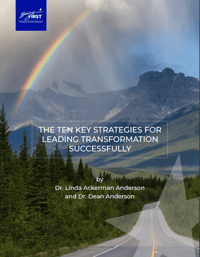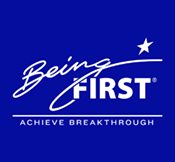Is Your Change Initiative Impaired by a "Hit and Run" Sponsor?
In any change initiative, the sponsor is one of the most important change leadership roles. This is especially true if your change initiative is transformational where real breakthrough is the goal. By now, you probably know the data that 60-70% of all change initiatives fail. As a change leader or change consultant, you rely on your change sponsor to ensure that your change initiative succeeds. As you may have experienced, the level of skill, knowledge, and thinking of change sponsors can vary drastically. Understanding the capability of your sponsors can help you to assist in their development as change leaders to up-level the quality of their sponsorship.
Less-Than-Optimal Change Sponsors
First let’s take a look at what less-than-optimal change sponsorship looks like. This type of change sponsor is what we call the “Bless and Delegate” or “Hit and Run” sponsor. These symptoms may be all too familiar to you: They announce the change initiative, delegate it to a person or project team and disappear. Often their expectations are unrealistic and they leave the solution design, plan, and deployment to the project team. Their focus is typically on meeting their schedule and budget, leaving out any consideration of the impact on people, capacity, and cultural dynamics. The schedule and budget is often not based on the reality of the actual work required to deliver the sponsor their intended outcomes. In addition, they often leave stakeholders with no voice or way to impact their new reality. Getting the solution installed is their priority, not how the people feel or think who must live with the solution. This type of sponsor usually causes politics and resistance, making it difficult for those impacted to embrace the change. All of this makes it really tough on change leaders and change consultants to influence a satisfying outcome.
Effective Change Sponsors: Transformational Change Leaders
Now let’s contrast that with the role of an executive sponsor who is a transformational change leader. A transformational change leader is committed to ensuring sustained business results from their projects and they understand how to set up change efforts for success. They ensure the design of a change strategy and process plan that will produce an optimal change solution so that the people who must make it happen are engaged, have a say, and are committed to being successful. These sponsors know they must address and demonstrate shifts in their own mindsets, behaviors, and culture to provide credibility to the effort. And they understand that transformational change is a process to be led and course corrected, not an announcement followed by metrics.
An effective executive sponsor will accomplish these leadership strategies in their role:
1. Set the Direction
- Articulate clear desired outcomes for the project, including organizational/technical and human/cultural requirements
- Clarify how the initiative supports achieving the business strategy
- Ensure that a viable change strategy is developed and communicated
2. Get People’s Attention
- Early on, demonstrate through word and action that this change effort is real
- Champion the project over time; demonstrate its staying power and ensure required attention and resources
- Wake up stakeholders to the full scope of change by clearly articulating how it will impact their personal mindsets, behavior and relationships, as well as their work
3. Ensure Executive Support
- Brief executives to ensure they understand how the desired outcomes serve the business strategy
- Ensure executives understand what will be required of them, their people, and resources, to support through to sustained results
- Establish mechanisms to manage the interface of the change initiative with on-going operations for the combined good of both
4. Model the Way
- Model the desired cultural norms in word, behavior, and action
- Actively engage in the personal mindset and behavioral changes required by the change initiative; make this overt
- Frequently ask for feedback about their own personal style and its impact on others and the success of the change initiative
5. Secure the Resources
- Commit the resources required to achieve outcomes
- Adjust resources as needed throughout the change initiative
- Ensure the effort is staffed with adequate skills (i.e., change leadership, project management, content expertise, employee engagement, and communications)
6. Free Up Capacity
- Reprioritize operational goals to make room for the change initiative work
- Reprioritize people’s workloads who must devote time to the change initiative (both project team and stakeholders), especially those in leadership roles
- Establish realistic pace and timeline for the effort given the resources and capacity available
7. Monitor the Process
- Establish regular mechanisms to stay informed about progress in both the solution and people’s receptivity
- Make course corrections! Adjust direction, expectations, and scope as needed
- Hold change leaders accountable for fulfilling their agreements and meeting objectives
8. Remain Actively Engaged
- Keep key stakeholders and those in leadership roles informed about information impacting the change initiative
- Remove organizational barriers as needed
- Participate in critical change tasks as requested
How to Develop your Sponsor’s Role from Ineffective to Effective
As we said, the level of skill and knowledge of change sponsors can vary drastically. So how can you help? What can you do to support your sponsor and drive the change you (and they) are committed to?
First, take a look at your current relationship with your sponsor and ask yourself the following questions:
-
Are you already well-connected and influential?
-
How do they perceive the expertise YOU bring to their change initiatives? What do they think you do for them?
-
When in their change initiatives do they reach out to you for help? At launch? After design?
-
What do they know of good sponsorship and the consequences of poor sponsorship? How would you describe their level of leading change?
Next, get the attention of project sponsor(s) and generate a trusted relationship required for their change initiatives to succeed.
-
Generate and present data on costly patterns from past change initiatives
-
Engage executives in this data and explore questions that raise their awareness and secure commitment in their change leadership roles
-
Brand your services to start on Day One so they know what to call on you for
-
Train, coach, advise in Conscious Change Leadership capabilities and strategies
In summary, there is a huge advantage to up-leveling the quality of sponsorship on change initiatives. This is work well worth investing in. The first step is to assess the reality—and the consequences—of the current sponsorship you have in your organization. Start there and get the conversation going!
Related Webinar:
Sponsor-Project Lead Partnership Best Practices Proven to Maximize Transformation Results
Instructor: Dr. Linda Ackerman Anderson
This webinar explores a four-step process for creating an effective sponsor-project lead partnership and the proven principles that drive it. You’ll get our best practices and tips for building a sponsor-project lead partnership derived from our 40+ years as experts in leading transformation.
Related Video:
Why Leadership Commitment and Alignment Are Critical to Transformation
Related eBook:
The Ten Key Strategies for Leading Transformation Successfully

Through 40 years of observing and supporting large-scale change and transformation in Fortune 500, government, global NGOs and public service organizations, we’ve identified these ten Best Practice strategies for leading transformation successfully.
Please complete the form to download your eBook:

